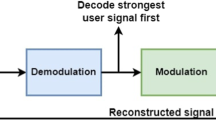Abstract
In 3rd generation partnership project (3GPP) long term evolution (LTE) systems, when no resources has been assigned in the uplink to a given user equipment (UE), the control information associated with layers 1 and 2 in the protocol stack is conveyed back to the base station through the so-called physical uplink control channel (PUCCH). In PUCCH, the data streams transmitted by multiple UEs are multiplexed in the time-domain and in the frequency-domain with the aid of spreading codes. Although the spreading codes associated with UEs within the same cell can be assumed to be orthogonal, the presence of inter-cell interference (ICI) in multi-cell scenarios severely limits receiver performance. In particular, the Format 1 of PUCCH, which is associated with the transmission of hybrid automatic repeat request acknowledgements (ACK/NACK) and scheduling requests, has a major impact on system performance, since an incorrectly decoded ACK/NACK message may introduce significant delay in data transmission. In this contribution, we propose a new multi-user receiver for ICI reduction in PUCCH LTE that operates both in cooperative and non-cooperative multi-cell architectures. The proposed receiver relies on a constrained tensor modeling of the received signal in PUCCH signaling, and affords an iterative joint channel estimation and symbol detection by simultaneously exploiting the energy of the data symbols and the pilot tones present in PUCCH. The formulation of the proposed algebraic receiver model incorporates symbol-basis hopping and slot-basis hopping signaling schemes, which are interference randomization techniques existing in the 3GPP specifications of LTE system. Computer simulation results show the remarkable performance gains of the proposed receiver compared to the conventional time-frequency decorrelator based receiver.














Similar content being viewed by others
Notes
As explicitly listed in LTE specifications, the spreading code sequences can be built from special QPSK-based sequences found from computer search [19].
References
Dahlman, E., Parkvall, S., Sköld, J., & Beming, P. (2008). 3G evolution: HSPA and LTE for mobile broadband (2nd ed.). Oxford, UK: Academic Press.
Astély, D. (2009). LTE: The evolution of mobile broadband. IEEE Communications Magazine, 47, 44–51.
Sesia, S., Toufik, I., & Baker, M. (2009). LTE: The UMTS long term evolution—from theory to practice (1st ed.). West Sussex, UK: Wiley.
Lin, S., & Costello, D. (2005). Error control coding. Upper Saddle River, NJ, USA: Prentice-Hall.
Burstrom, P., Falahati, S., & Simonsson, A. (2008). Uplink control channel in E-UTRA radio link and radio network evaluation. IEEE wireless communications and networking conference (WCNC’08) (pp. 835–839). NV: Las Vegas.
Elayoubi, S., & Ben Haddada, O. (2007). Uplink intercell interference and capacity in 3G LTE systems. In The IEEE international conference on networks (ICON’07) (pp. 537–541). SA: Adelaide.
Nakao, S., Takata, T., Imamura, D. & Hiramatsu, K. (2009). Performance enhancement of E-UTRA uplink control channel in fast fading environments. In The IEEE vehicular technology conference (VTC’09 Spring) (pp. 1–5). Barcelona.
Stuber, G. L. (1996). Principles of mobile communications (1st ed.). Boston, MA, USA: Kluwer.
Raghavendra, M. R., Nagaraj, S., Pradap, K. & Fleming, P. (2009). Robust channel estimation and detection for uplink control channel in 3GPP-LTE. In The IEEE global telecommunications conference (GLOBECOM’09) (pp. 1–5). Honolulu.
Van de Beek, J., Edfors, O., Sandell, M., Wilson, S. & Borjesson, P. (1995). On channel estimation in OFDM systems. In IEEE vehicular technology conference 2 (pp. 815–819). Chicago.
Ming-Xian, C., & Su, Y. (2002). Model-based channel estimation for OFDM signals in Rayleigh fading channels. IEEE Transactions on Communications, 50(4), 540–544.
Morelli, M., & Mengali, U. (2001). A comparison of pilot-aided channel estimation methods for OFDM systems. IEEE Transactions on Signal Processing, 49(3), 3065–3073.
Wu, Y., Danev, D., & Larsson, E. G. (2012). Improved detection of ACK/NACK messages in the LTE uplink control channel. IEEE Vehicular Technology Conference (VTC Spring), 1(1), 1–5.
Wu, Y., Danev, D., & Larsson, E. G. (2012). On ACK/NACK messages detection in the LTE PUCCH with multiple receive antennas. European Signal Processing Conference (EUSIPCO), 1(1), 994–998.
Chaitanya, T. V. K., Larsson, E. G., & Wiberg, N. (2010). Improved error protection for uplink control signaling in 3GPP-LTE via complex-field coding. In IEEE Vehicular Technology Conference (pp. 1–7). Taipei.
Ming-Xian, C., & Su, Y. (2004). Blind and semiblind detections of OFDM signals in fading channels. IEEE Transactions on Communications, 52, 744–754.
Cui, T., & Tellambura, C. (2007). Semiblind channel estimation and data detection for OFDM systems with optimal pilot design. IEEE Transactions on Communications, 55, 1053–1062.
Yang, H., Astely, D., Baldemair, R., & Falahati, S. (2009). Semi-blind multi-user detection for LTE PUCCH. In Proceedings of the IEEE wireless communications and networking conference (Vol. 1, No. 1, pp. 1–5). Budapest.
TS 36.211 v8.9.0. Evolved Universal Terrestrial Radio Access (E-UTRA); Physical Channels and Modulation. Third Generation Partnership Project 3GPP, Tech. Spec. Release 8.
Sidiropoulos, N. D., Giannakis, G. B., & Bro, R. (2000). Blind PARAFAC receivers for DS-CDMA systems. IEEE Transactions on Signal Processing, 48(3), 810–822.
de Almeida, A. L. F., Favier, G., & Mota, J. C. M. (2008). A constrained factor decomposition with application to MIMO antenna systems. IEEE Transactions on Signal Processing, 56(6), 2429–2442.
de Almeida, A. L. F., Favier, G., & Mota, J. C. M. (2009). Space-time spreading-multiplexing for MIMO wireless communication systems using the PARATUCK-2 tensor model. Signal Processing, 89(11), 2103–2116.
Favier, G., da Costa, M. N., de Almeida, A. L. F., & Romano, J. M. T. (2012). Tensor space-time (TST) coding for MIMO wireless communication systems. Signal Processing, 92(4), 1079–1092.
de Almeida, A. L. F., Favier, G., & Ximenes, L. R. (2013). Space-time-frequency (STF) MIMO communication systems with blind receiver based on a generalized PARATUCK2 model. IEEE Transactions on Signal Processing, 61(8), 1895–1909.
Liu, K., da Costa, J. P. C. L., So, H. C., & de Almeida, A. L. F. (2013). Semi-blind receivers for joint symbol and channel estimation in space-time-frequency MIMO-OFDM systems. IEEE Transactions on Signal Processing, 61(21), 5444–5457.
da Silva, I. L. J., de Almeida, A. L. F., Cavalcanti, F. R. P., Baldemair, R., & Falahati, S. (2010). A multi-user receiver for PUCCH LTE in non-cooperative multi-cell architectures. In The IEEE vehicular technology conference (VTC Fall’10). Ottawa, Canada.
da Silva, I. L. J., de Almeida, A. L. F., Cavalcanti, F. R. P., Baldemair, R., & Falahati, S. (2010). A multi-user receiver for PUCCH LTE format 1. In The 11th IEEE international workshop on signal processing advances in wireless communications (SPAWC’10). Marrakech, Morocco.
da Silva, I. L. J., de Almeida, A. L. F., Cavalcanti, F. R. P., Baldemair, R., & Falahati, S. (2010). Improved data-aided channel estimation in LTE PUCCH using a tensor modeling approach. The IEEE International Conference on Communications (ICC’10) (pp. 1–5). South Africa: Cape Town.
Paulraj, A., Nabar, R., & Gore, D. Introduction to space-time wireless communications, 1st ed. Cambridge University Press, UK.
TS 36.101 v9.2.0. Evolved Universal Terrestrial Radio Access (E-UTRA); user equipment (ue) radio transmission and reception. Third Generation Partnership Project 3GPP, Tech. Spec. Release 8.
Harshman, R. A. (1970). Foundations of the PARAFAC procedure: Model and conditions for an “explanatory” multi-mode factor analysis. UCLA working papers in phonetics (Vol. 16, pp. 1–84).
Bro, R. (1998). Multi-way analysis in the food industry: Models, algorithms and applications. PhD thesis, University of Amsterdam, The Netherlands.
Author information
Authors and Affiliations
Corresponding author
Rights and permissions
About this article
Cite this article
da Silva, Í.L.J., de Almeida, A.L.F., Baldemair, R. et al. A Multi-user Receiver for Inter-Cell Interference Reduction in LTE PUCCH Signaling. Wireless Pers Commun 75, 2523–2547 (2014). https://doi.org/10.1007/s11277-013-1481-5
Published:
Issue Date:
DOI: https://doi.org/10.1007/s11277-013-1481-5




